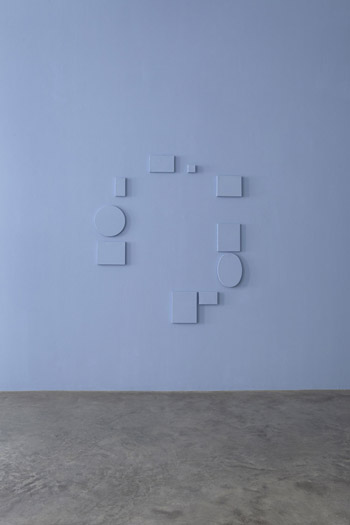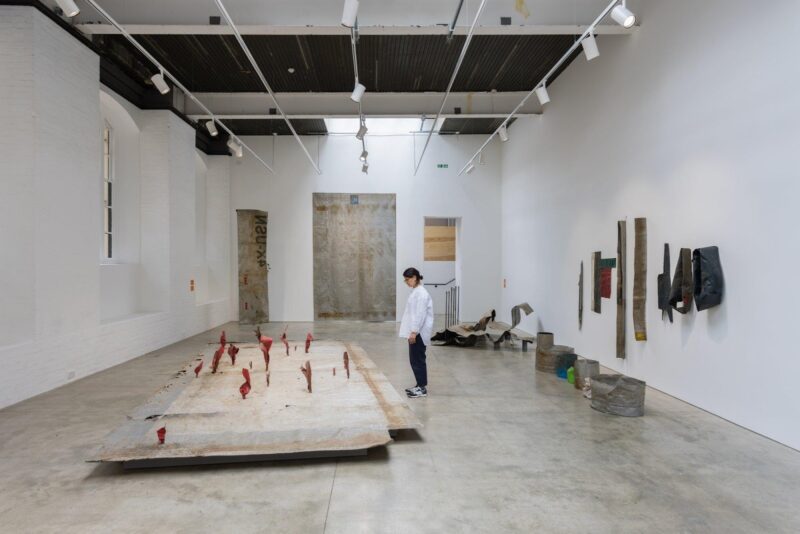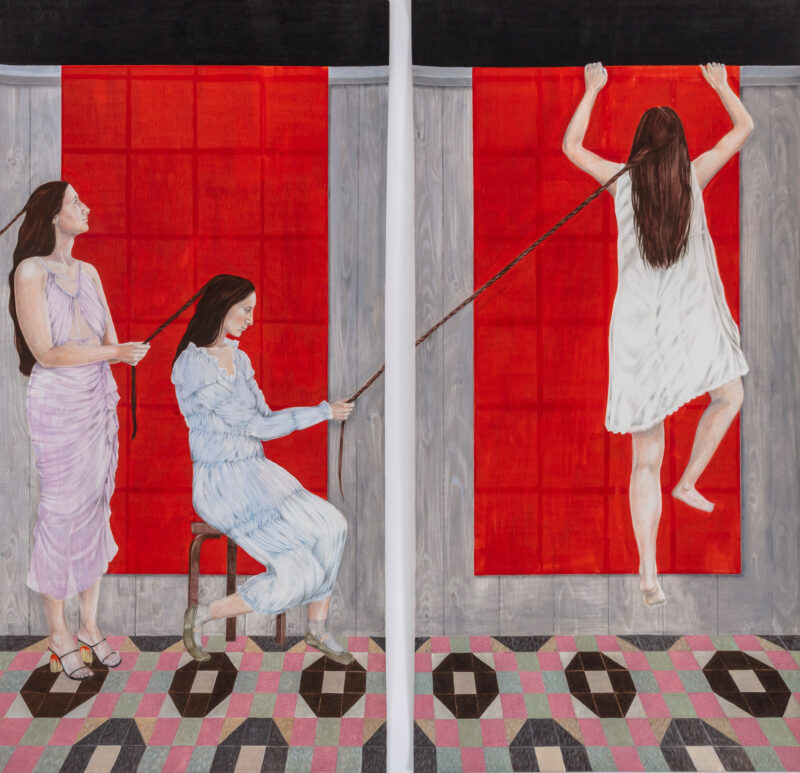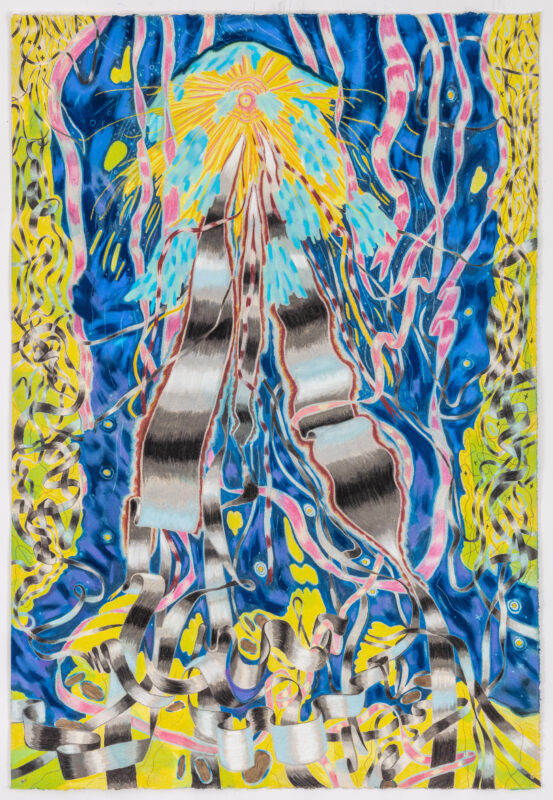
Image:“définition/méthode 257 : hors cadre” 1994,
Opening on Saturday 8th January, 2011, 4 – 9 PM
Saturday 8th January 2011, 7pm, during the opening:
Auction by Christies of a work presented in Claude Rutault’s exhibition
Galerie Emmanuel Perrotin, 76 rue de Turenne, 75003 Paris
Claude Rutault’s first personal exhibition from January 8 to February 12 in my gallery. The exhibition will bring together 23 works in 10 rooms in the gallery. Historical works from the 1970s in particular (definition-method 208c paint, depaint, repaint and definition/method 98. to be continued), and nine new works will be presented for the occasion. It is a new stage in a story between Claude and I that goes back 20 years.
I met Claude Rutault in 1987 thanks to Dominique Pasqualini, a member of Information Fiction Publicité (IFP), a group of artists who currently present a retrospective at Mamco in Geneva.
I was a young gallery assistant and Claude Rutault’s work opened me up to conceptual art, although Claude Rutault doesn’t see himself as a conceptual artist, but as a painter (which no longer surprises me, because Bernard Frize doesn’t see himself as a painter). Back in 1989 already, I offered to computerise Claude Rutault’s archives. In 1992, I offered to organise an exhibition. Rutault kindly refused both proposals. Finally, twenty years later, in September 2010, Claude agreed to a group exhibition. Having renewed our collaboration it seemed obvious to prolong it with a personal exhibition.
I would like to enable Rutault’s work to be understood and circulated on the international scene with the same critical and institutional success that he enjoys in France. At the end of the exhibition, the gallery will publish the first monograph of the artist in English.
Claude Rutault’s work is elaborated with a vocabulary that was established in 1973 in definition/method 1, ‘a canvas braced on a stretcher, painted the same colour as the wall on which it is hung. All commercially available formats can be used, be they rectangular, square, round or oval.’ The identity of the canvas colour with the wall has led to development of a corpus of over 300 definitions/methods. Rutault’s texts form the instructions of an evolving work that is ‘updated’ by its ‘taker’ (collector, museum…). In an absolute gesture, all of Rutault’s paintings prior to 1973 have been entirely repainted following the same principle. The artist has broken away from the strict colour identity between the canvas and the wall by taking his paintings away from the wall: canvases are stacked, placed on the floor or up against the walls…
Rutault’s works integrate the market dimension of art and do not hesitate to draw inspiration from it. In this way, definition/method 189. at number 189 we sell, 1988, is defined by its very selling process. The auction conducted by Christie’s on the day of the opening will involve a stack of 40 white canvases. With each bid, one canvas from the stack will be removed and go to TRANSIT, a storage space for ‘mediums that have served or will serve to update or re-update existing definitions/methods.’ It is the auction process that will define the composition of the work. The higher the price rises, the smaller the work becomes.
We have dared to let a wolf into the fold. I’d like to take this occasion to thank Christie’s for participating in this novel project. Another work, composed of six stacks of paintings, definition/method 290. the jinxed stack, 2010, changes with every subsequent sale of the piece. Stack after stack, with each resale the work will join a museum collection, playing on the reconciliation between private collections and museum collections, and the frustration artists experience every time a work is resold. Rauschenberg will thus be avenged by Claude Rutault’s mischief.
Claude Rutault is creating two new suicide paintings for the exhibition, evoking the eight suicide paintings of 1978. These canvases painted the same colour as the wall on which they hang will only be exhibited once. definition/method 291. exhibition-suicide 1 will be destroyed if it has not found a taker by the last day of the exhibition. definition/method 292. exhibition-suicide 2 will be taken down at the end of the first day of the exhibition: either the canvas will have been purchased and the taker will take immediate possession of it, or it will not have been purchased and will be immediately destroyed.
definition/method 295. blind painting, 2010, is equally radical. The rule is that the work stays in a locked room. The only person allowed to go inside the room will have bought the work without seeing it. They can imagine its definitive form. ‘The person undertaking constructs the work and the artist has to guess its updating’ from behind the door. The stake behind this mystery is the price of the work, multiplied or divided by two. The artist no longer determines the work’s configuration and it is chance that decides the price. definition method 311. painting-puzzle 5, endless and definition/method 258b. puppets partake in the same iconoclastic, playful spirit.
definition/method 108 B. série noire, 1978-2010, forms a countdown collection which, paradoxically, is finished. ‘initially the person undertaking purchases the first 37 of the série noire crime novel collection whose title, and in some cases more than the title, relates to painting. he then sets about looking for the rest of these titles. this choice of 179 titles has its own logic that plays on unexpected registers.’
Claude Rutault keeps a discussion going with art history. definition/method 301: canvas against the wall, Mondrian 3, 2010, makes a direct reference to Mondrian’s painting La Place de la Concorde, 1938. Rutault’s canvas stretcher installed on the wall copy its black lines and coloured zones are represented by papers installed on the adjacent wall following the original composition. Two other works presented in the show definition / method 307. a saturday morning on ile de la grande jatte, or elsewhere, 2010, and definition / method 308. portrait of……by édouard manet. claude rutault, 1986, grab and mime the works of Georges Seurat and Edouard Manet.
Claude Rutault has had a highly important role in art in France since the 1970s. He has inspired numerous contemporary artists. He formulates a critical analysis of the art world, founded on the social operation between the work and the artist, their gallery, the collector, the museum and now the auction house. The scenarios Rutault writes do not become works until they are undertaken. definition / method 318. in painting everyone positions their pawns, 2010, highlights the social play-off between collectors who share a work. Two collectors together purchase two stacks of round canvases. Each puts their stack with their other works. They exchange these canvases as and when acquisitions and sales occur in their respective collections.
The title of this exhibition is exhibition suicide. Beyond the reference to the whole game in the French art world that expects exhibiting at the Galerie Perrotin to be suicidal in relation to Claude Rutault’s public, this violent title reminds us that the definitions/methods are the medium for a non-finished work that can also lead to its own disappearance. definition/method 310. painting-grave, 2001, introduces the idea of the artist’s physical disappearance by changing form on the day of his death. This issue and these black works are treated with great humour and distance. This renders a new interpretation of this title possible, a reference to a new departure, a renaissance.
Emmanuel Perrotin
A monography of the artist is launched by Editions Flammarion.
Claude Rutault. 24 x 28 cm. 240 pages. 40€. Text by Michel Gauthier, discussion by Marie-Hélène Breuil.
A monography in English will be published by Galerie Perrotin in 2011.







